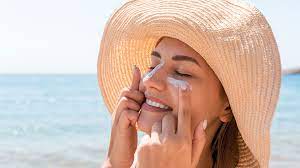


Summer beckons with its warm glow, inviting us to soak up the sunshine. But while the sun provides essential Vitamin D, its ultraviolet (UV) rays can damage our skin. To truly enjoy the season, sun safety becomes paramount. This guide equips you with the knowledge to choose the right sunscreen, implement effective sun protection strategies, and prioritize hydration – all crucial for healthy, summer fun.Sun rays are most harsh and damaging to skin during peak sun hours, which typically range from 10 am to 4 pm. This is because the sun is highest in the sky during this timeframe, and its rays travel more directly down to Earth, resulting in a stronger intensity of ultraviolet (UV) radiation reaching the surface.
The Right Sunscreen: Your First Line of Defense
Sunscreen acts as a shield, absorbing or reflecting UV rays before they penetrate your skin. Choosing the right one is vital for optimal protection. Here’s why:
Understanding UV Rays:
There are two main culprits – UVA and UVB. UVA rays penetrate deep into the skin, causing premature aging and wrinkles. UVB rays are responsible for sunburns and contribute to skin cancer. A broad-spectrum sunscreen safeguards against both.
SPF: Decoding the Sun Protection Factor: Sun Protection Factor (SPF) indicates a sunscreen’s ability to block UVB rays. An SPF 30 sunscreen blocks about 97% of UVB rays, while SPF 50+ blocks over 98%. While SPF 50+ offers slightly more protection, SPF 30 is sufficient for most everyday activities. However, for fair skin, extended sun exposure, or activities like swimming or hiking, SPF 50+ becomes more crucial.
Sunscreen Selection: Tailored to Your Skin Type
Just like clothing, sunscreen isn’t a one-size-fits-all solution. Consider your skin type for optimal results:
Oily Skin: Opt for lightweight, oil-free formulas like lotions or gels. These absorb quickly and won’t clog pores.
Dry Skin: Choose moisturizing creams that hydrate while protecting. Look for ingredients like hyaluronic acid or ceramides.
Sensitive Skin: Fragrance-free, hypoallergenic options are best. Mineral sunscreens containing zinc oxide or titanium dioxide tend to be gentler.
Beyond Sunscreen: Sun Protection Strategies
Sunscreen, though essential, is just one piece of the sun safety puzzle. Here are additional strategies to shield your skin and health:
Cover Up: Clothing provides excellent sun protection. Opt for long sleeves, pants, and wide-brimmed hats. Look for tightly woven fabrics or clothes with a UPF (Ultraviolet Protection Factor) rating, which indicates the level of UV protection the fabric provides.
Sunglasses for Eye Health: Protect your eyes from UV damage with sunglasses that block UVA and UVB rays. Choose styles that wrap around the sides for added protection.